Introduction to the Endocrine System
1/39
There's no tags or description
Looks like no tags are added yet.
Name | Mastery | Learn | Test | Matching | Spaced |
|---|
No study sessions yet.
40 Terms
Endocrine definition
Referring to Glands which SECRETE hormones or other products DIRECTLY into the blood
Exocrine definition
Glands which SECRETE their products through DUCTS opening on to an epithelium (Body surface) rather than directly into the blood.
Eg. Sweat, Tears, Saliva, Milk and Digestive juices
What is included in the Endocrine system - give some examples
Brain:
Hypothalamus
Controls the pituitary gland.
Acts as a bridge between the nervous system and endocrine system.
Pituitary Gland
Known as the "master gland."
Secretes many hormones, some of which control other glands.
Pineal Gland
Secretes melatonin.
Helps regulate circadian rhythms (sleep-wake cycle).
Neck Area:
Thyroid Gland
Affects metabolism, among other functions.
Parathyroids
Help regulate calcium levels in the blood.
Abdomen / above the Kidneys:
Adrenal Glands
Located above the kidneys.
Help trigger the "fight-or-flight" response (release of adrenaline).
Pancreas
Regulates blood sugar levels by secreting insulin and glucagon.
Reproductive Organs:
Testis (in males)
Secretes male sex hormones (e.g., testosterone).
Ovary (in females)
Secretes female sex hormones (e.g., estrogen, progesterone).
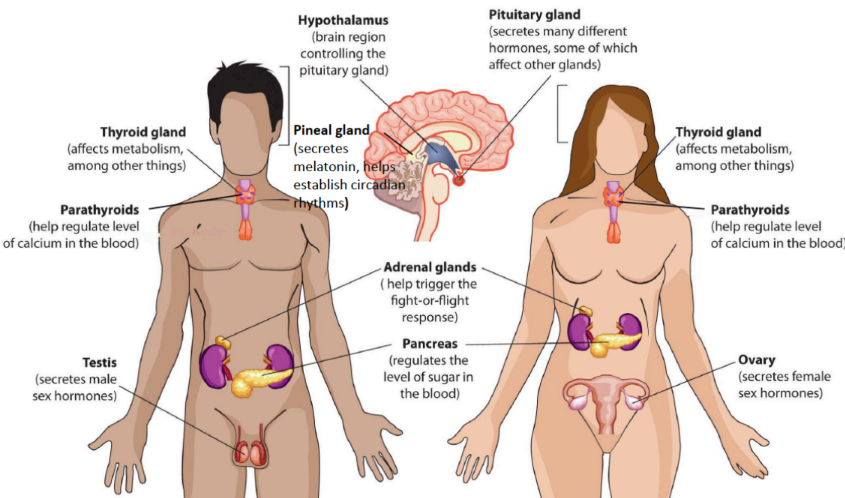
Hypothalamus
Brain region controlling the pituitary gland.
Connects the nervous system with the endocrine system
pituitary gland
secretes many different hormones, some of which affect other glands
Pineal gland
Secretes melatonin and helps establish circadian rhythms
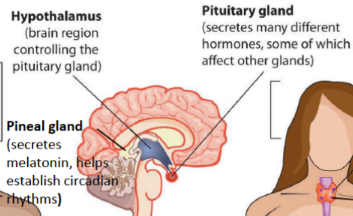
Thyroid glands
Contain thyroid follicular cells. Secretes T4 OR T3 which affects metabolism and growth.
Iodine is in the chemical structure
Parathyroids gland (embedded through the thyroid gland)
Help regulate the level of calcium in the blood
The parathyroid makes PTH - involved in calcium metabolism (increases blood calcium)
Stimulating bones to release calcium. / Increasing calcium absorption in the kidneys. / Activating vitamin D (which helps the intestines absorb calcium).
Adrenal glands
helps trigger fight or flight response
e.g. adrenaline and noradrenaline amongst other hormones
Pancreas
-Regulates the level of sugar in the blood
-Secretes insulin, glucagon
-located behind the stomach
Testis
secretes male sex hormones
Ovary
secretes female sex hormones
estrogen and progesterone
What are the 4 functions of the Endocrine system?
• Development - [Proliferation, growth, differentiation, organogenesis]
• Reproduction - [Sexual maturation & behaviour, maintenance of pregnancy, lactation]
• Metabolism - [Carbohydrate, energy storage, metabolic rate, temperature]
• Homeostasis - [Water balance, salt levels, blood volume, pressure] Body to maintain a constant internal environment
How does the endocrine system work?
- Hormones are the messenger molecules of the endocrine system - they work by altering the structure and/or activity of the target cell by binding to specific hormone receptors
Examples:
Stimulating DNA synthesis
Affecting transcription/translation of mRNAs (sex hormones)
Affecting channel proteins & enzymes by modifying their shape (e.g. catecholamines)
Helps to maintain homeostasis → a constant internal environment (all feedback loops used for this)
What is a hormone?
- a substance secreted by the cells of endocrine glands/tissues that regulates the activity of other cells in the body
- Hormones are released into the blood stream, transported to their distant target cells in the blood and act on these target cells via specific receptors
- Different target cells express receptors for different hormones
What are the different types of hormone?
Amino acid-derived (e.g. Catecholamines: adrenaline and noradrenaline)
Peptide - short and/or long chains of amino acids (e.g. insulin)
Lipid-derived - derived from lipids such as cholesterol (steroid) or arachidonic acid (eicosanoids) [e.g Testosterone and Progesterone]
![<ol><li><p><strong><mark data-color="red" style="background-color: red; color: inherit">Amino acid-derived</mark> </strong>(e.g. Catecholamines: adrenaline and noradrenaline)</p></li><li><p><strong><mark data-color="red" style="background-color: red; color: inherit">Peptide</mark> </strong>- short and/or long chains of amino acids (e.g. insulin)</p></li><li><p><strong><mark data-color="red" style="background-color: red; color: inherit">Lipid-derived</mark> </strong>- derived from lipids such as cholesterol (steroid) or arachidonic acid (eicosanoids) <strong>[e.g Testosterone and Progesterone]</strong></p></li></ol><p></p>](https://knowt-user-attachments.s3.amazonaws.com/347585df-2b4a-487b-a3b9-1d213a062bfe.png)
What are amino acid derived hormones?
Amino acid derived hormones are structurally based on one of two amino acids: Tyrosine or Tryptophan
Tyrosine-based hormones:
Thyroid hormones e.g., T3, T4 both produced by thyroid glands
Catecholamines e.g., adrenaline (epinephrine) , noradrenaline (norepinephrine), dopamine
Note: both Thyroxine and adrenaline have similar structures to amino acid tyrosine as shown in image attached - hence why they are tyrosine amino acid derived hormones
Tryptophan-based hormones:
Melatonin produced by the pineal gland
All but the thyroid hormone BIND to cell membrane receptors. Receptor activation triggers the appearance of a second messenger [e.g. cAMP, cGMP or Ca2+-] in the cytoplasm which triggers the hormone response.
Thyroid hormone acts differently as it can cross the plasma membrane via diffusion and through transport proteins. It binds to intracellular (cytoplasmic) receptors which trigger transcription and mRNA production. Moreover, it increases ATP production by binding to receptors at the mitochondria.
![<p>Amino acid derived hormones are structurally based on one of two amino acids: <strong>Tyrosine or Tryptophan</strong></p><p><strong><u>Tyrosine-based hormones:</u></strong></p><ul><li><p>Thyroid hormones e.g., T3, T4 both produced by thyroid glands</p></li><li><p>Catecholamines e.g., adrenaline (epinephrine) , noradrenaline (norepinephrine), dopamine</p></li></ul><p>Note: both Thyroxine and adrenaline have similar structures to amino acid tyrosine as shown in image attached - hence why they are tyrosine amino acid derived hormones</p><p></p><p><strong><u>Tryptophan-based hormones:</u></strong></p><ul><li><p>Melatonin produced by the pineal gland</p></li></ul><p></p><ul><li><p>All but the thyroid hormone <strong><mark data-color="red" style="background-color: red; color: inherit">BIND to cell membrane receptors</mark></strong>. <strong><mark data-color="blue" style="background-color: blue; color: inherit">Receptor activation triggers the appearance of a second messenger [e.g. cAMP, cGMP or Ca2+-] in the cytoplasm which triggers the hormone response. </mark></strong></p></li><li><p><strong><mark data-color="purple" style="background-color: purple; color: inherit">Thyroid hormone acts differently as it can cross the plasma membrane via diffusion and through transport proteins.</mark></strong> It binds to intracellular (cytoplasmic) receptors which trigger transcription and mRNA production. Moreover, it increases ATP production by binding to receptors at the mitochondria.</p></li></ul><p></p>](https://knowt-user-attachments.s3.amazonaws.com/4bd967b8-a84d-4089-986a-38763a1347a3.jpg)
Image for structure of tryptophan / based hormone melatonin
Structural similarity between melatonin and tryptophan (an amino acid) showing it is a amino acid derived hormone
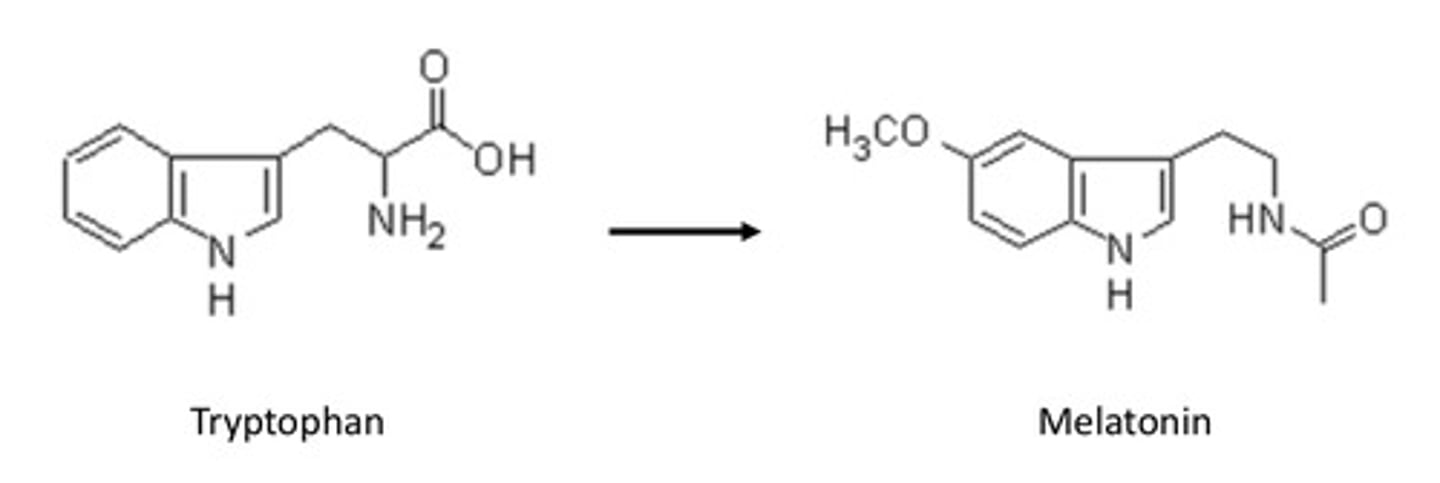
How do amino-acid-derived hormones trigger responses?
- All amino-acid derived hormones but thyroid hormones bind to cell membrane receptors
- Activation of the receptor triggers the appearance of second messengers (cAMP , cGMP or Ca) in the cytoplasm which then triggers the hormone response
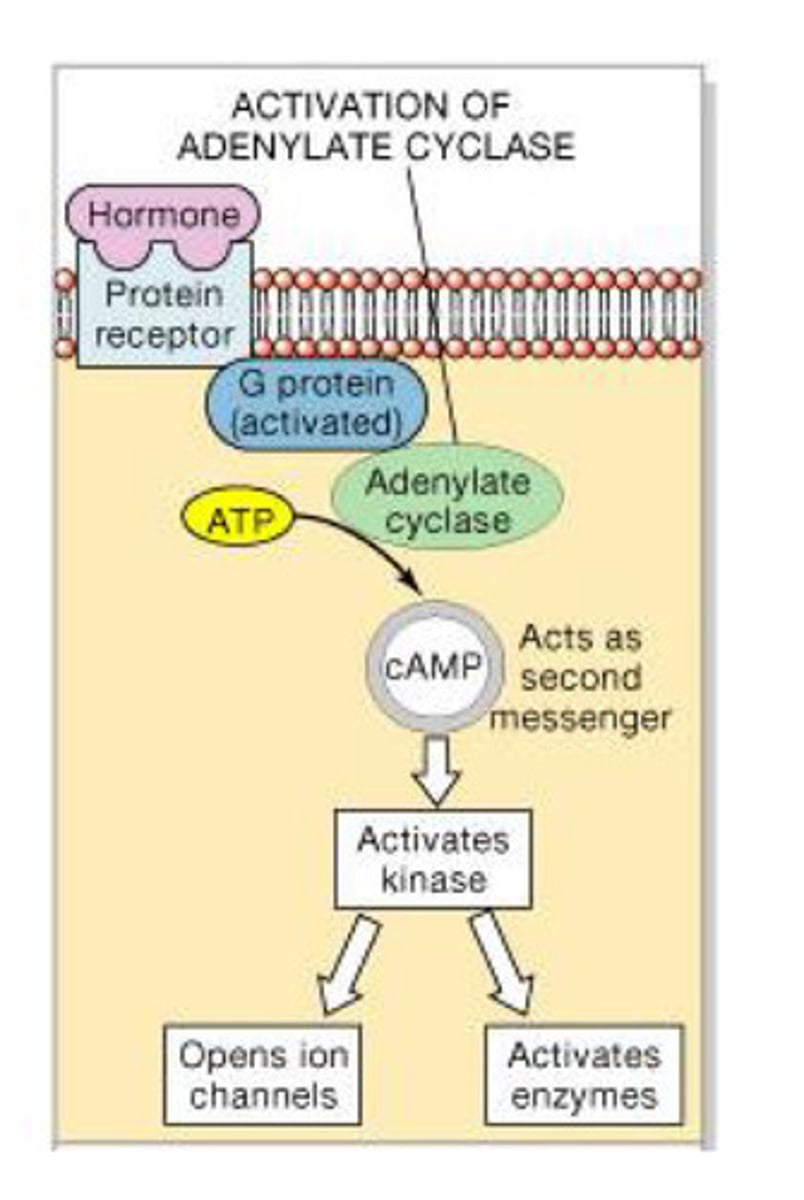
Kinase enzyme group
The addition of a phosphate
Phosphotase group
The subtraction of a phosphate
How does thyroid hormone act differently to trigger responses in comparison to other amino acid derived hormones ?
- Thyroid hormone acts differently as it can cross the plasma membrane via diffusion or a transport protein
- It binds to intracellular (cytoplasmic) receptors which triggers transcription and mRNA production
- OR it binds to receptors at the mitochondria which increases ATP
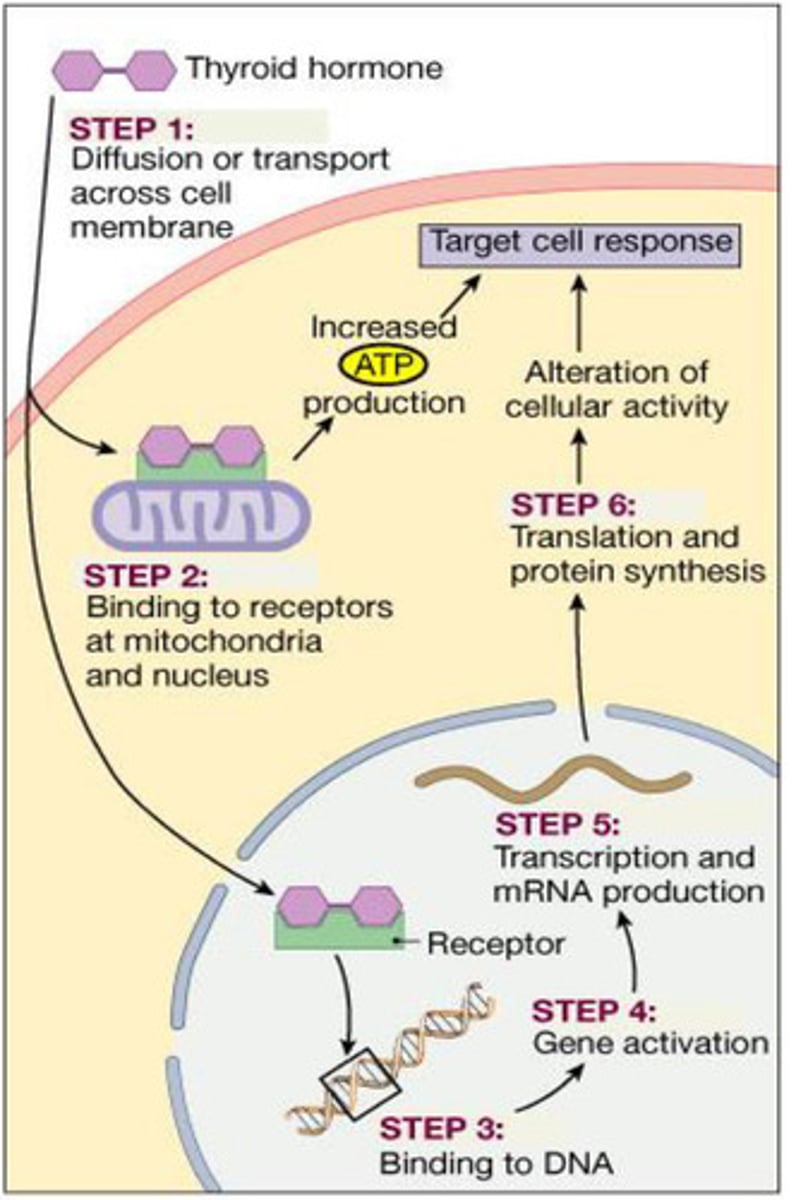
Transcription
the process of making a messenger RNA (mRNA) copy of a DNA sequence
What are peptide hormones?
Peptide hormones are hydrophilic, able to interact with cell membrane receptors & can be:
Peptides: oxytocin, ADH
Polypeptides: insulin, growth hormone
Glycoproteins (follicle stimulating hormones): LH, FSH, TSH
Peptides won't act in the cytoplasm as they are too big
What are the two pathways in which peptide hormones can be secreted?
Regulated secretion:
The cell stores hormone in secretory granules and released them in bursts when stimulated e.g. insulin triggered by an increase of glucose in the blood
Mechanism:
1) Insulin is synthesised in the beta cells of the pancreas in insulin secreting granules
2) Upon increase of blood glucose levels, glucose enters the pancreas beta cells via glucose transporters where it will be metabolised which will cause the release of ATP
3) This increase in ATP will close ATP sensitive K+ channels which will change the electronic charge of the cell membrane
4) This allows the voltage sensitive calcium channel to be opened - calcium moves into the beta cells via diffusion = phosphorylation of various proteins (insulin receptor substrates) which allows the insulin in the granules to be fused onto the cell membrane and then released into the blood
—
Constitutive secretion:
The cell does not store hormone but secretes it from secretory vesicles as it is synthesised e.g., FSH (follicle-stimulating hormone) or testosterone
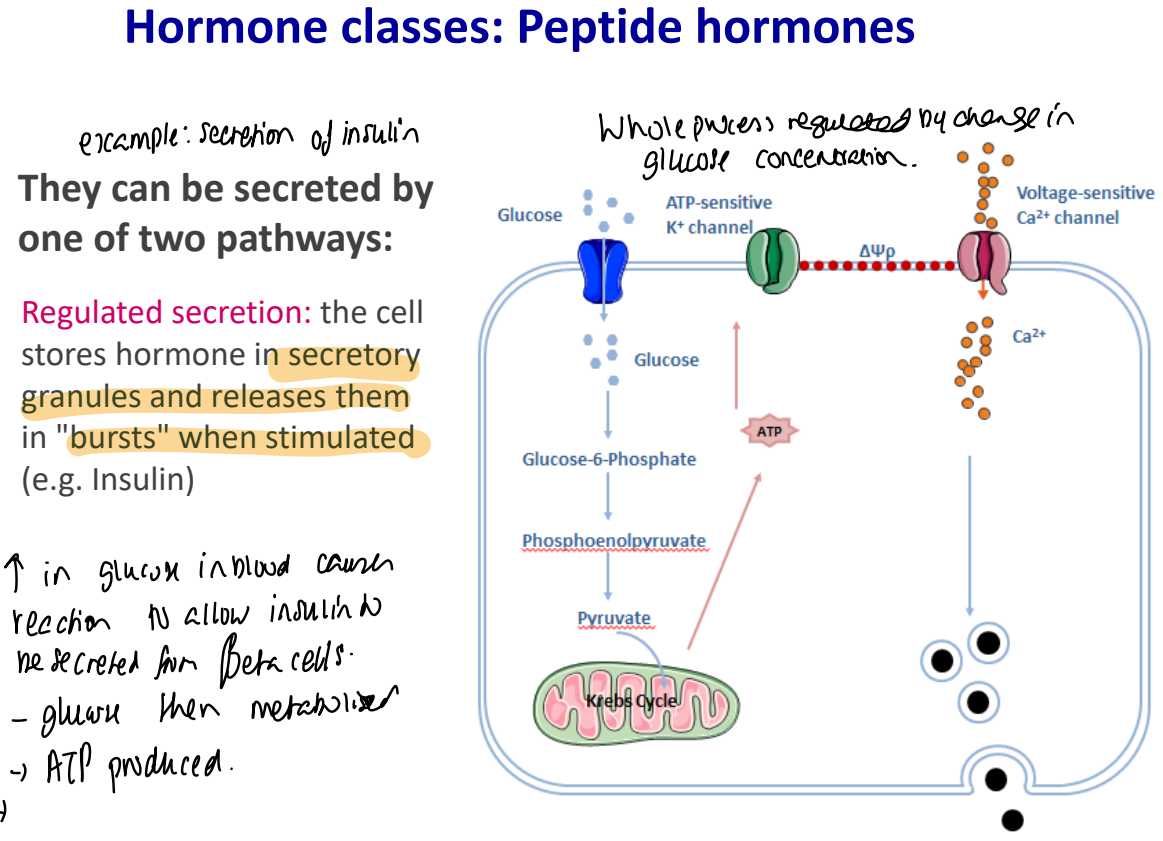
Amino acid hormones
Based on Tryptophan and tyrosine
Steroid hormones
based on cholesterol
What are lipid-derived hormones (four ring structure) - e.g. sex hormones or cortisol hormones?
- Lipid derived hormones are derived from lipids such as cholesterol (steroid) or arachidonic acid (eicosanoids)
- Lipid-derived hormones are lipophilic meaning they can enter the cell by crossing the plasma membrane
-They then bind to intracellular cytoplasmic receptors and regulate gene transcription by binding to hormone-response elements in DNA
- Example: Testosterone stimulates the production of structural proteins in skeletal muscle fibres which increase muscle size and strength
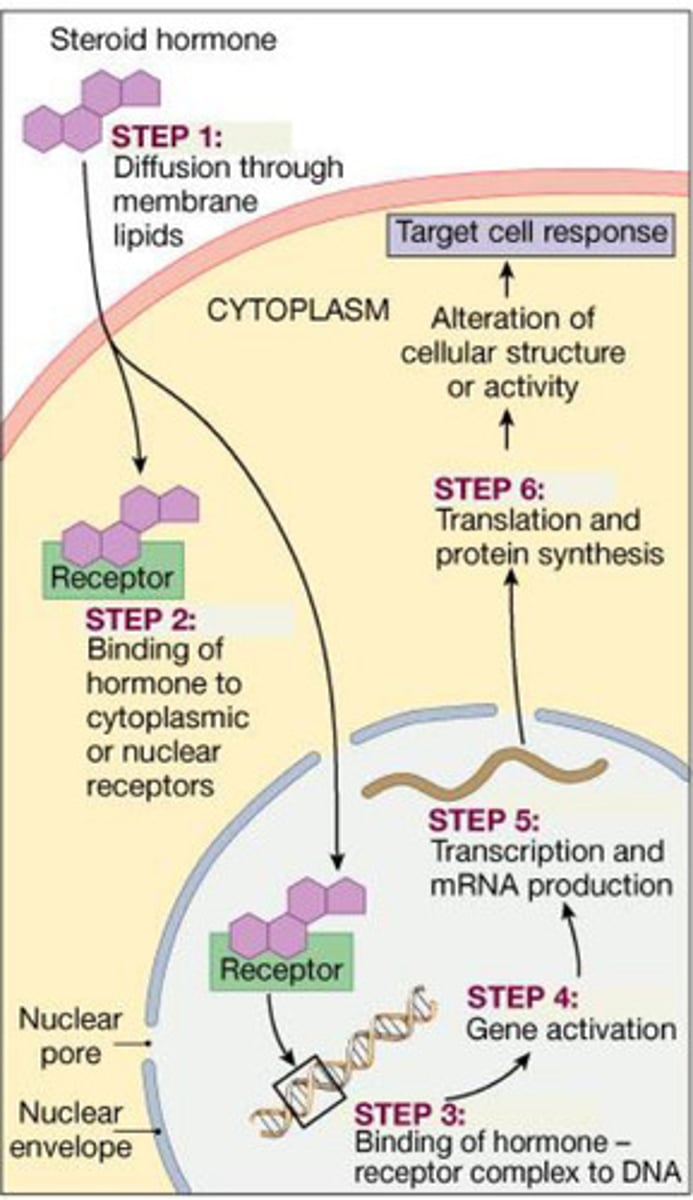
Explain what we mean when we describe a cell as a target cell for a particular hormone.
A cell is a target cell because it has a specific receptors for a given
hormone
What are the 2 different types of hormone receptors?
-Cell membrane receptors
-Intracellular receptors
List and describe the 3 features of Cell membrane receptors
o Extracellular domains (hydrophillic) are residues exposed to the outside
of the cell and interact with the hormone
o Transmembrane domains are hydrophobic stretches of
amino acids found within the lipid bilayer and anchor the
receptor in the membrane
o Intracellular domains are parts of the receptor within the
cytoplasm and respond to hormone binding by activating
second messengers, opening ion channels and activating
enzymes
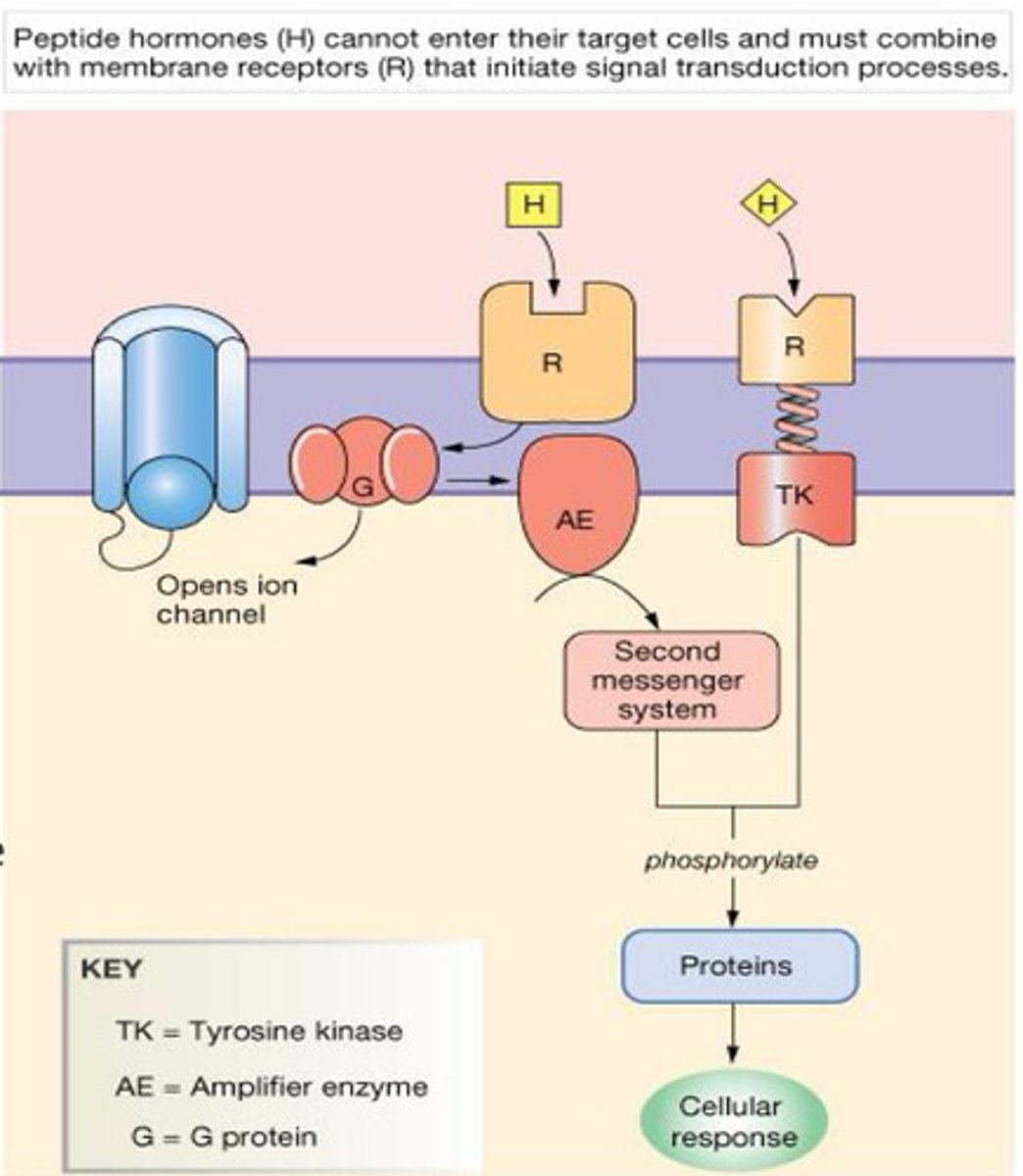
List and describe the 2 types of Cell membrane receptors
o Enzyme-linked/catalytic receptors whereby a binding of an
extracellular ligand causes enzymatic activity on the
intracellular domain e.g., insulin receptor, tyrosine kinase
receptor (tyrosine will be responsible for phosphorylating insulin receptor substrates)
o G-protein coupled receptors like Glucagon-like peptide 1
are either excitatory or inhibitory and involve second
messengers
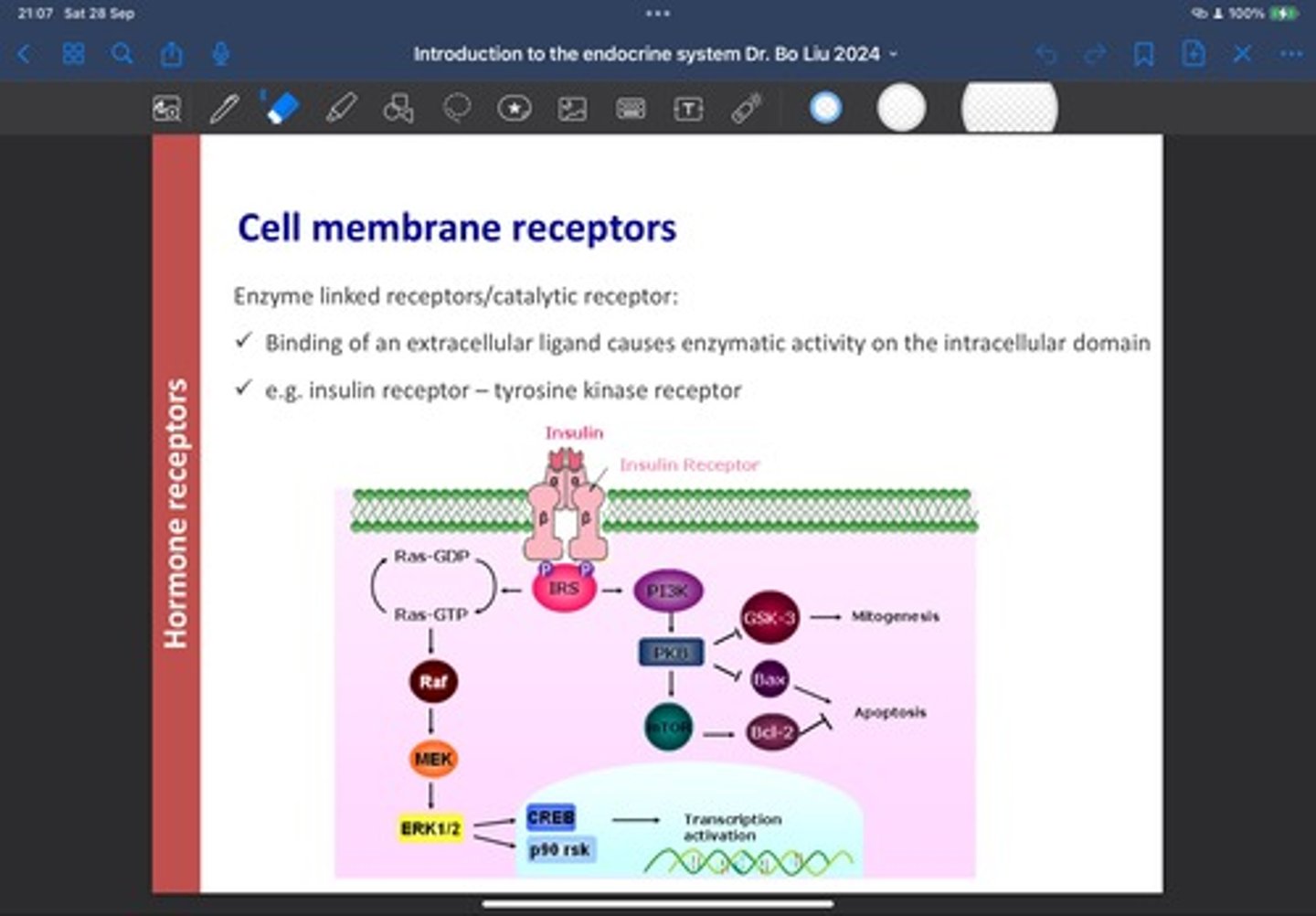
Diagram for above - GPCR
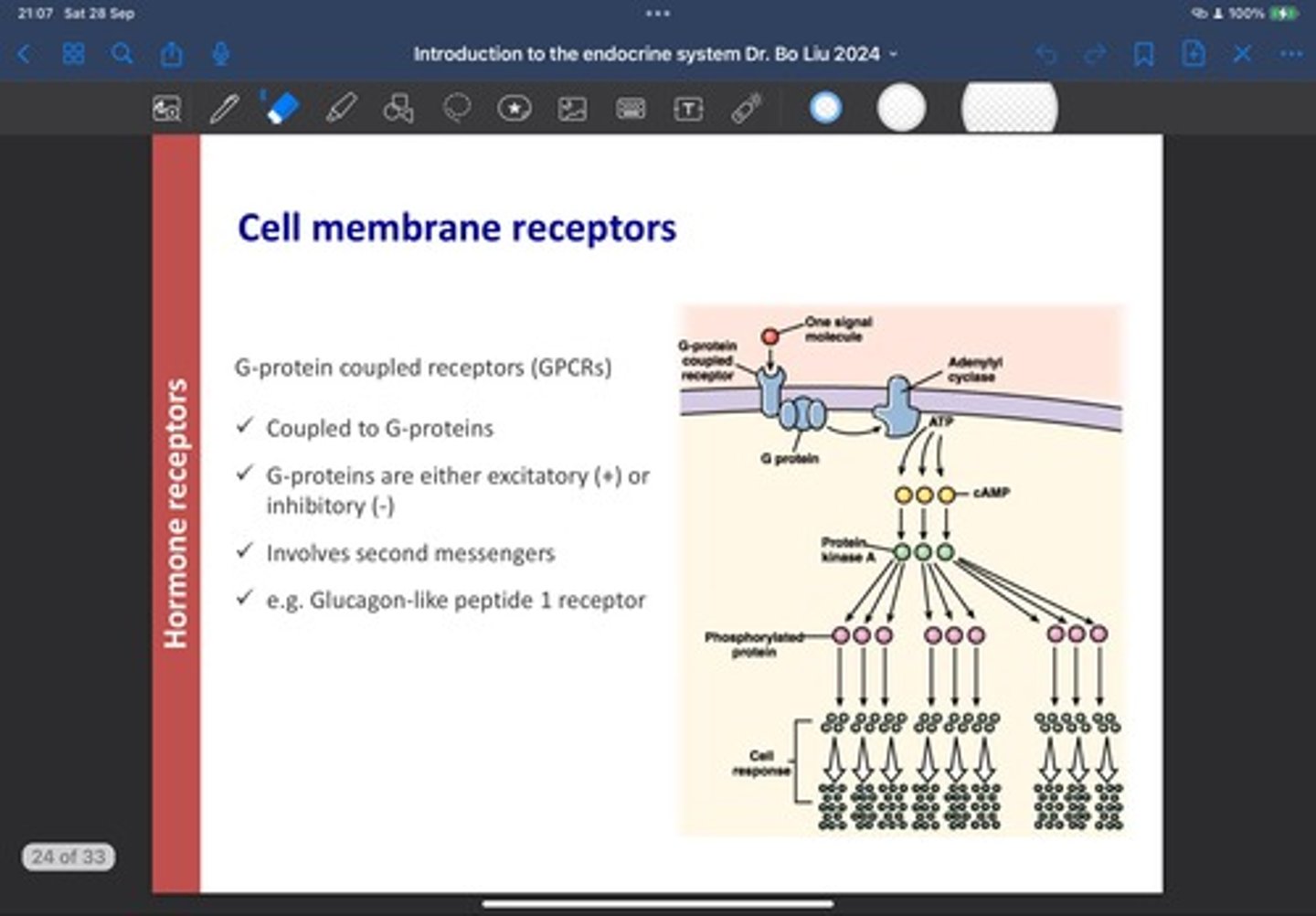
Where are intracellular receptors located and how does feedback control of hormone secretion take place here?
-Located either in cytoplasm or nucleus (within the cell membrane)
- External stimulus activates the endocrine cell (this stimulus is
specific for the endocrine cell type)
- The endocrine cell releases hormone into the blood (hormones are
rapidly cleared from circulation via liver/kidney)
- The response reduced the stimulus as part of a negative feedback
control loop to ensure homeostasis
Describe feedback control of insulin secretion from pancreatic
beta cells
- An increase in plasma glucose concentration is the external
stimulus
- The increase in plasma glucose concentration activates insulin-
secreting cells which increases insulin secretion
- This increase in insulin secretion increase plasma insulin
concentration
- The increase in plasma insulin concentration enables insulin to
reach its target cells consequently increasing the actions of insulin
to transport glucose from plasma to inside cells via glucose transporters = reduces the
stimulus of increased plasma glucose
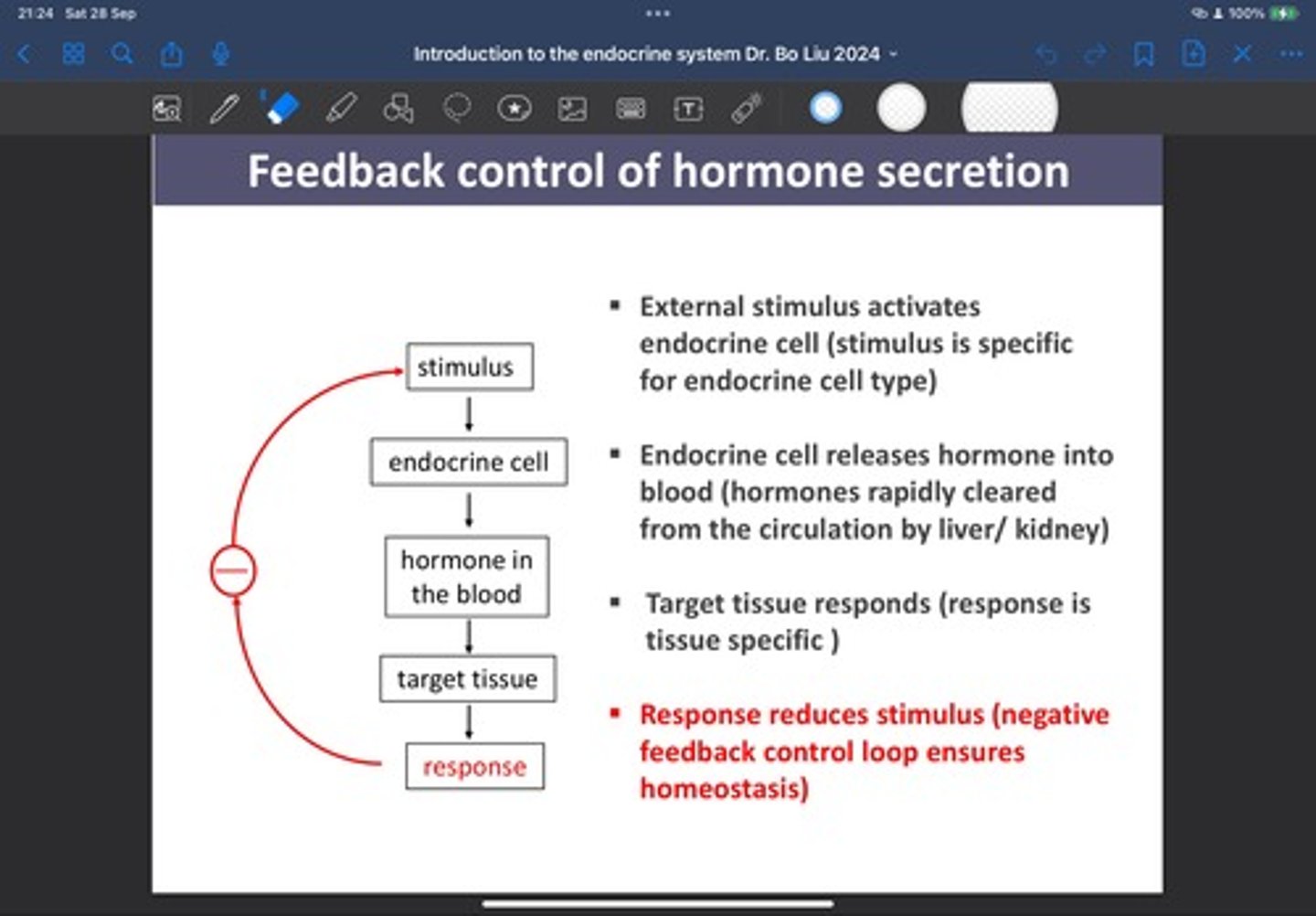
What is the difference between negative and positive feedback
loops?
- Negative feedback involves the response counteracting the
stimulus by shutting off the response loop e.g., TSH (Thyroid stimulating hormone) produces T3
and T4 & T3 and T4 negatively affect TSH production
- Positive feedback involved the response reinforcing the stimulus
sending the parameter further from the setpoint and requires an
outside factor to shut off the feedback cycle e.g., more oxytocin release when more contraction of the uterus during
parturition (childbirth)
Oxytocin
a hormone that plays a role in many aspects of human behaviour and reproduction
What is meant by long and short feedback loops?
-The secretion of hormones are regulated via feedback loops (mostly negative)
-The response can involve multiple organs
Example:
When the Hypothalamus releases Cortical Releasing Hormone (CRH - a protein), this triggers the Anterior Pituitary to release Adrenocorticotropic hormone (ACTH) which triggers the Adrenal Cortex to release Cortisol.
Cortisol can generate a negative feedback loop to switch of the release ACTH.
At the same time, Cortisol can also feedback to the hypothalamus to switch off the release of CRH, which is described as a long feed back loop because it involves 3 endocrine organs (Hypothalamus, Anterior pituitary and the Adrenal cortex)
Note:
ACTH can also feedback to the Hypothalamus to switch off the release of CRH which is also a short negative feedback loop
-Can be controlled in a more controlled way
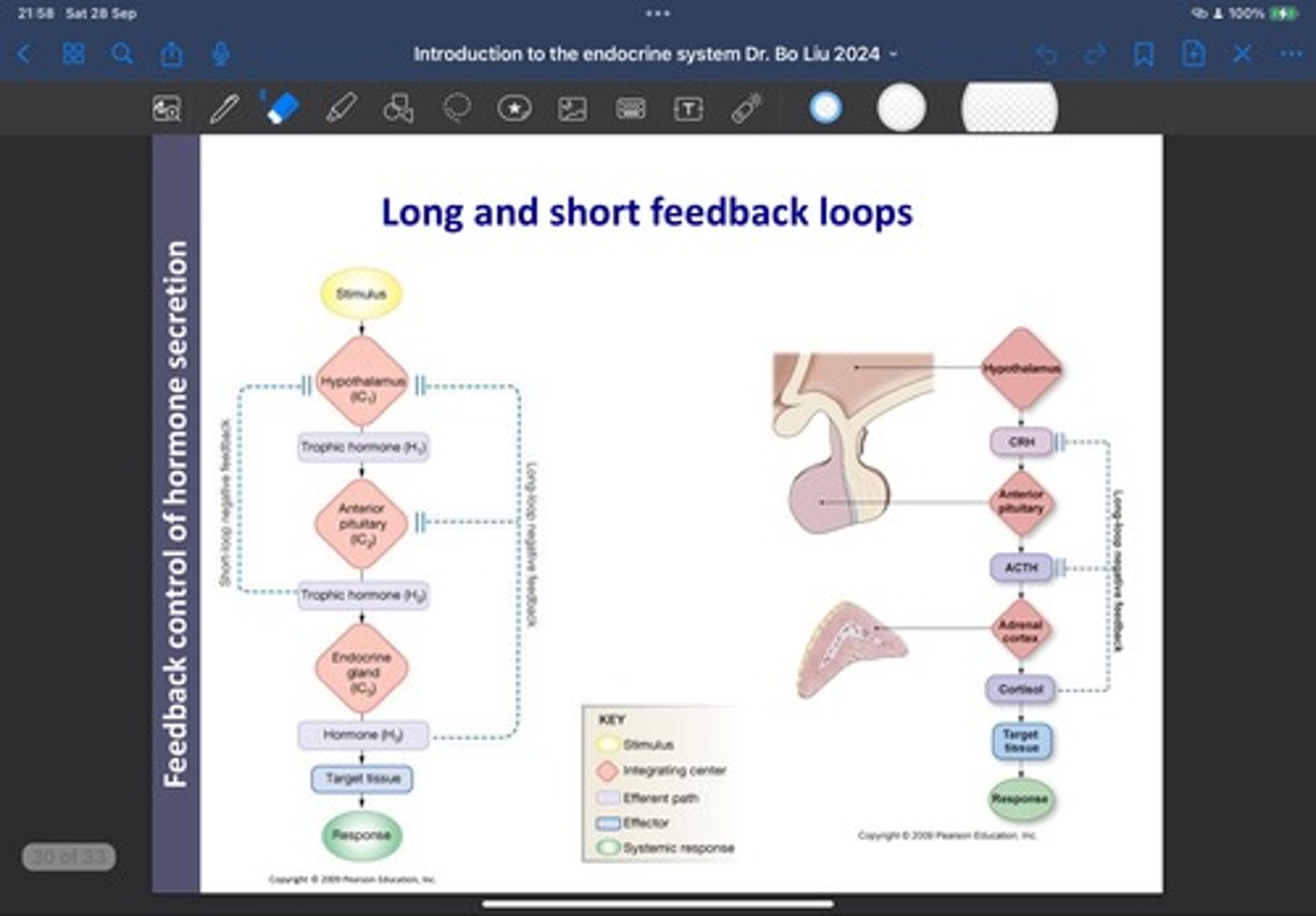
What is the result of homeostatic controls?
- Successful control = homeostasis established
- Failure to control = illness and/or death
List and describe some disorders of the endocrine systems - feedback loops out of sync
- Excessive hormone secretion- acromegaly (a rare condition where the body produces too much growth hormone, causing body tissues and bones to grow more quickly), giantism due to too
much growth hormone and Cushing’s syndrome due to too much
cortisol;
- Deficient hormone secretion-Type 1 Diabetes due to no insulin,
Addison’s disease due to lack of adrenal cortisol, thyroid insufficiency
- Failure to respond to a hormone-Type 2 Diabetes due to insulin
resistance, growth hormone receptor defects